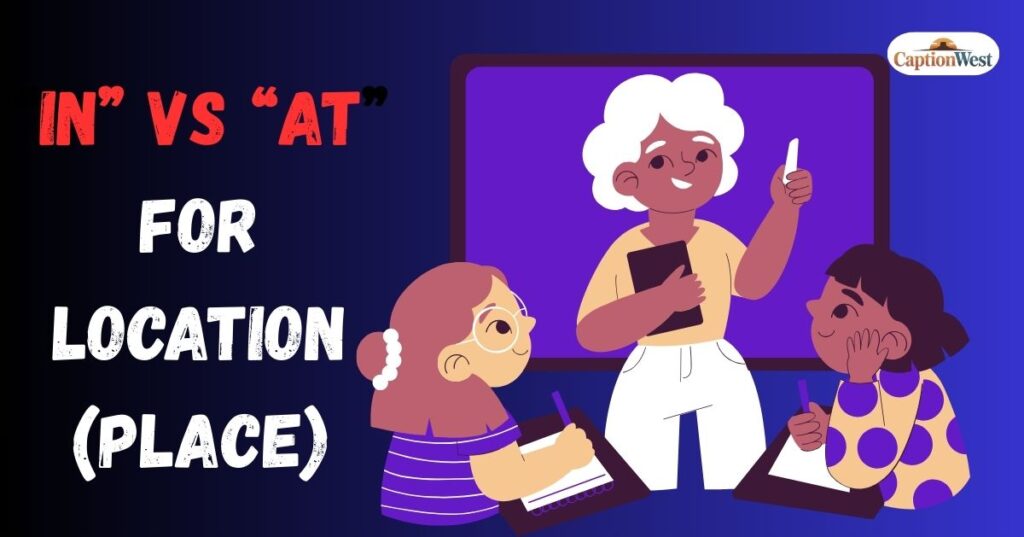If you’ve ever wondered whether to say “I’m in New York” or “I’m at New York,” you’re not alone. English learners often struggle with prepositions, and one of the most confusing pairs is “in” vs “at.” Both are common prepositions of time and place, but their usage depends on specificity and context.
In this guide, we’ll explore the difference between in and at with detailed explanations, grammar rules, real-life examples, common mistakes, and even regional variations between American and British English. By the end, you’ll feel more confident about choosing the right preposition in both writing and conversation.
What Is the Main Difference Between “In” and “At”?
The main difference between in and at lies in how specific you want to be.
- In emphasizes being inside or within a space, area, or time frame.
- At emphasizes being at a point, location, or exact moment.
Think of it this way:
- “In” = inside boundaries (room, city, year, container).
- “At” = precise point (address, time, event).
Example:
- ✅ She is in the kitchen. (inside the kitchen)
- ✅ She is at the door. (specific point: the door)
“In” vs “At” for Location (Place)

Using In for Places
The preposition in is used when referring to:
- Enclosed spaces (room, box, drawer, building).
- Larger areas (city, country, continent).
- Abstract boundaries (organization, group, world).
Examples:
- I live in Paris.
- The keys are in the drawer.
- She works in a software company.
Using At for Places
The preposition at is used when referring to:
- A point or specific spot.
- Addresses or events.
- Landmarks or meeting points.
Examples:
- Let’s meet at the bus stop.
- He is at 25 Oxford Street.
- I saw her at the concert.
Quick Comparison
- ✅ I’m in the library. (inside the building)
- ✅ I’m at the library. (referring to the library as a location, not necessarily inside)
“In” vs “At” for Time

Using In for Time
In is used for general, non-specific time periods such as:
- Months, years, centuries.
- Parts of the day.
- Future time frames.
Examples:
- She was born in 1995.
- We usually study in the evening.
- I’ll finish the project in three days.
Using At for Time
At is used for specific points in time such as:
- Exact hours.
- Holidays and festivals.
- Particular moments.
Examples:
- The train arrives at 6:30 p.m.
- The event starts at midnight.
- Let’s meet at Christmas.
Common Mistakes with “In” and “At”
Even advanced learners often mix up these prepositions. Let’s look at some typical errors and corrections.
| ❌ Wrong Sentence | ✅ Correct Sentence | Rule |
| The concert is at Wednesday. | The concert is on Wednesday. | Use on for days. |
| Your appointment is at 3 March. | Your appointment is on 3 March. | Use on for dates. |
| I always read at the morning. | I always read in the morning. | Use in for parts of the day. |
| She has been living at New York. | She has been living in New York. | Use in for cities. |
| The book is at the backpack. | The book is in the backpack. | Use in for containers. |
| He will meet us in 7 o’clock. | He will meet us at 7 o’clock. | Use at for specific times. |
Regional Differences: British vs American English
English usage can vary slightly between regions.
- UK English → at the weekend
- US English → on the weekend
- UK English → play in a team
- US English → play on a team
- UK English → at university
- US English → in college
Example:
- UK: We’re going to Brighton at the weekend.
- US: We’re going to Miami on the weekend.
Practice Examples: In vs At
Location
- ✅ I left my phone in the car.
- ✅ I left my phone at the station.
- ✅ She is in the office.
- ✅ She is at her desk.
Time
- ✅ We usually travel in December.
- ✅ The meeting is at 9 a.m.
- ✅ They got married in 2010.
- ✅ The movie starts at midnight.
Quick Comparison Table: “In” vs “At”
| Context | Use “In” | Use “At” |
| Place | Inside, within, enclosed area. e.g., in the room, in New York, in a box | Point, event, address. e.g., at the bus stop, at home, at the party |
| Time | Non-specific/general. e.g., in July, in the morning, in the 1990s | Specific/exact. e.g., at 5 p.m., at noon, at Christmas |
Why “In” and “At” Are Not Interchangeable
Swapping one preposition for the other often changes meaning or makes the sentence incorrect.
Example:
- She is in the hospital. (She is a patient there.)
- She is at the hospital. (She could be visiting, working, or outside the building.)
This subtle difference shows why prepositions of place and time must be learned carefully.
Mini Quiz: Test Your Knowledge
- Which sentence is correct?
- A) He is in the bus stop.
- B) He is at the bus stop. ✅
- A) He is in the bus stop.
- Which sentence is correct?
- A) She will arrive in 8:00.
- B) She will arrive at 8:00. ✅
- A) She will arrive in 8:00.
- Which sentence is correct?
- A) The party is in Friday.
- B) The party is on Friday. ✅
- A) The party is in Friday.
- Which sentence is correct?
- A) The book is at the bag.
- B) The book is in the bag. ✅
- A) The book is at the bag.
- Which sentence is correct?
- A) I was born in 1992. ✅
- B) I was born at 1992.
- A) I was born in 1992. ✅
Read Must : Difference Between Each and Every: Complete Grammar Guide with Examples
Why It’s Important to Learn the Difference Between “In” and “At”
For English learners, mastering the difference between in and at is essential because these prepositions often change the entire meaning of a sentence. If you say “She is in the hospital” versus “She is at the hospital,” the context completely shifts. The difference between in and at is not just about grammar rules but about expressing the right idea in the right context. Understanding the difference between in and at helps avoid confusion in both spoken and written English.
Practical Tips to Remember the Difference Between “In” and “At”
If you still mix them up, here are some quick hacks to recall the difference between in and at easily:
- Think of “in” as something enclosed or inside (e.g., in a room, in a city).
- Think of “at” as a point or location (e.g., at the bus stop, at the door).
- When it comes to time, use “in” for general references (in 2025, in the morning) and “at” for exact times (at 5 p.m., at midnight).
By practicing with real-life sentences, you’ll naturally remember the difference between in and at and use them correctly without hesitation.
Conclusion
The difference between in and at comes down to specificity and context.
- Use in when talking about being inside a space or within a general time frame.
- Use at when referring to a precise point in place or time.
- Remember: they are not interchangeable, and using the wrong one can completely change the meaning of a sentence.
With practice, these grammar rules will become second nature. Next time you’re about to write or say a sentence with in or at, think about whether you’re talking about being inside something (in) or *at a specific point (at).

